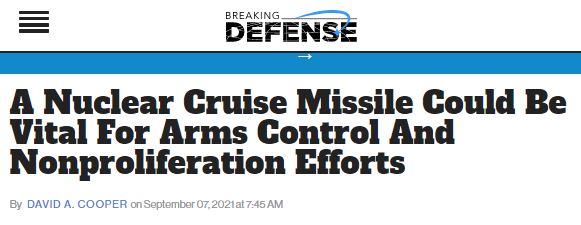Moar Weapons For Moar Arms Control
This article clearly enunciates a particular strain of conventional wisdom and coats it in sugar.
You too can have moar arms control and moar nonproliferation by making moar kinds of weapons and moar of them! The magic factor is called “leverage,” which along with “deterrence” is what moar weapons give you!
It’s the commonest argument out there. At this moment, a thousand reps from the companies that build these things are making it to a thousand military officers. But it leaves out a lot.
Both leverage and deterrence describe situations involving what the other side thinks. The article mentions none of that. In order to do that, it would have to describe how the weapons are to be used, where they might be based, and what of the adversary’s assets they threaten. It would have to cite material that the adversary’s military experts have written and analyze how these weapons undercut or threaten the adversary’s expectations and weapons.
Ah, but this pitch offers something new:
But too often overlooked in this debate are important arms control and nonproliferation considerations, which need to be factored in when discussing whether or not to move forward with the new system. The reality is that the SLCM-N offers an opportunity for arms control advocates in the US government to leverage new capabilities and, potentially, force Russia and China to new agreements.
Look at that! Leverage to FORCE Russia an China to new agreements.
Pardon me. That reminds me of one of my favorite comics, from the early fifties.
They are talking about the hydrogen bomb. That certainly FORCED PEACE RIGHT DOWN THEIR BLOODTHIRSTY THROATS!
The argument that moar weapons will help arms control is that on the one hand they will have this forcing quality and on the other, they can be traded away. Please. Nobody ever built a weapons system in order to trade it away, although we have a candidate in our swiss-cheese antiballistic missile system.
On nonproliferation, moar weapons will increase our allies’ confidence in our ability to protect them. Whether that increase in confidence will remain after the weapons are removed for arms control is not addressed.
If we are serious about arms control or deterrence, we must understand what motivates our adversaries. Or our allies, for nonproliferation. The article contains none of that.
Cross-posted to Nuclear Diner




